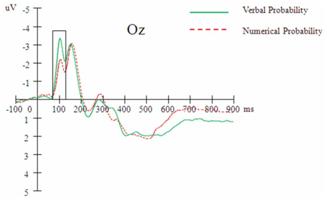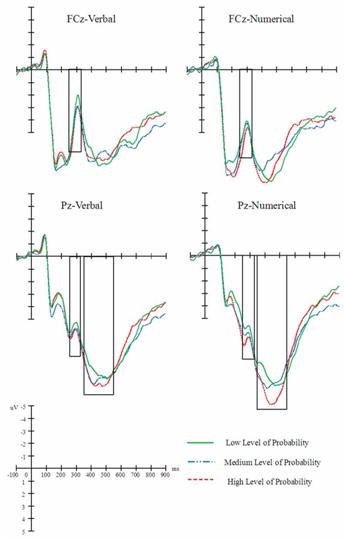ERP Correlates of Verbal and Numerical Probabilities in Risky Choices: A Two-Stage Probability Processing View |
Author: Prof.LI Shu's Research Group Update time: 2016/01/27 |
 |
Text Size: A A A |
|
Human lives in an uncertain world. Daily, people have to make decisions under uncertainty because they usually can’t control all the factors influencing the consequences of their decisions. Two kinds of probability expressions, verbal and numerical, have been used to characterize the uncertainty that we face. Previous studies have shown that verbal and numerical probabilities differ in a number of ways. However, behavioral analyses have indicated that people remain consistent between the two modes of response. Behavioral evidence is indirect in nature and leaves unresolved the question of whether the cognitive processing of verbal and numerical probabilities is similar. Verbal and numerical probabilities are different modes of assessing uncertainty, but they are similar in that they both present uncertainty. According to the levels-of-processing concept, the processing of probability can be divided into two steps, early sensory processing and later semantic-associated operations. In the early sensory processing period, differences in the modes of probability expression (verbal or numerical) may affect the processing of uncertainty. In the later semantic-associated operations, the two different modes of probability expression could have attained some degree of consistency in their response at any given level of probability. Considering that the high time resolution of the event-related potential (ERP) technique in cognitive neuroscience allows scientists to observe human brain activity that reflects specific cognitive processes over time, in the present study Dr. LI Shu's research team from the Institute of Psychology investigated the neural processing of verbal and numerical probabilities by exploring the high temporal resolution of ERP recordings. Consistent with the levels-of-processing framework, the ERP results provide neural evidence for similar processing of verbal and numerical probabilities. The time sensitivity of the ERP revealed that verbal probability and numerical probability elicited different N1 amplitudes but similar N2 and P3 waveforms (Figures 1 and 2). These results indicated the existence of two processing stages with identifiable neural substrates, stimulus identification and semantic access, in probability perception during decision making. In the early sensory processing period, the different modes of probability expression (verbal or numerical) affected the ERP waveforms. In the later semantic-associated operations, the different modes of probability expression showed some degree of consistency at any given level of probability. Taken together, the current findings provide neural evidence that there is internal consistency between verbal and numerical probabilities. Specifically, they support a view of a two-stage probability processing in which verbal and numerical probabilities are first translated into a common metric and then the semantic meaning of probability (high vs. low) is considered. This work was partially supported by the National Natural Science Foundation of China (No. 31170976; 31300843; 31200782; 31571161), Key Project of the Chinese Academy of Sciences (No. KJZD-EW-L04), Foundation for the Supervisor of Beijing Excellent Doctoral Dissertation (20138012501) and Beijing Natural Science Foundation (No. 7133250). The paper is now available online from Frontiers in Human Neuroscience. 
Figure 1.Averaged event-related potential (ERP) waveforms (n = 25) elicited by verbal and numerical probability at the Oz electrode. 
Figure 2.Averaged ERP waveforms (n = 25) elicited by the level of probability in the verbal and numerical probability conditions at the FCz and Pz electrodes. The Author's relevant papers onVerbal and Numerical Probabilities are as follows: Stephens, R. G., Dunn, J. C., Rao, L. L., & Li, S. (2015). Exploring the knowledge behind predictions in everyday cognition: an iterated learning study. Memory & Cognition, 43(7), 1007-1020. DOI: 10.3758/s13421-015-0522-6 Wang, Y., Du, X-L., Rao, L-L., &Li, S. (2014). Probability expression for changeable and changeless uncertainties: An implicit test.Frontiers in Psychology. 5:1313. doi: 10.3389/fpsyg.2014.01313 Du, X-L., Liu, S-H., Xu, J-H., Rao, L-L., Jiang, C-M., &Li, S. (2013). When uncertainty meets life: the effect of animacy on probability expression.Judgment and Decision Making.8(4), 425-438. Xu, J-H., Ye, X-B., &Li, S. (2009). Communication mode preference paradox among native Chinese speakers.Journal of Social Psychology, 149(1), 125 – 129. Contact: LI Shu Institute of Psychology, Chinese Academy of Sciences lishu@psych.ac.cn |
|
